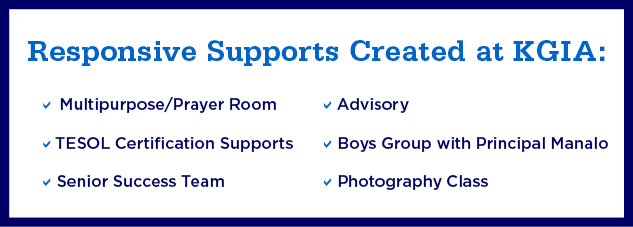Listening to Students: Building Culturally Responsive Supports for a Diverse Student Body
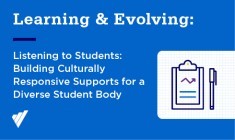
Over the last two years, educators at The Khalil Gibran International Academy (KGIA) have developed specific strategies to listen and respond to their multilingual, multiethnic, multicultural student body, simple but sincere strategies that have countered chronic absenteeism and low graduation rates. From opening a prayer room for students of any faith, to launching an advisory, to supporting teachers in becoming TESOL certified, KGIA has taken a series of steps to sustain students’ cultures and languages in support of both their academic and social-emotional needs. The result: KGIA saw its highest graduation rate ever, a 22% increase in students categorized as not at risk for absenteeism from 2019 to 2022, and and greater feelings of connectedness to the school community.
At the start of the 2021-2022 school, KGIA welcomed 54 Freshmen, 36 of whom are multilingual learners whose home languages include Arabic, Bengali, Chinese, Fulani, Mandarin, Pashto, Spanish, Tadshik, and Urdu. Of those 36 students, 13 do not speak English and 12 are multilingual English speakers. Additionally, roughly 73% of students recently immigrated to the U.S. in the last one to two years.
“We are so diverse linguistically this year, it's fantastic,” said Principal Carl Manalo enthusiastically. “It’s a good challenge to have!”
Principal Manalo doesn’t see student diversity as a challenge, but rather an opportunity to prioritize getting to know new learners, intentionally and individually.
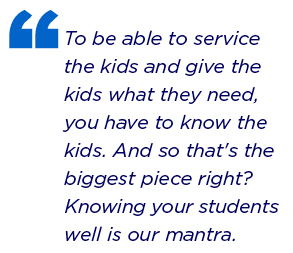
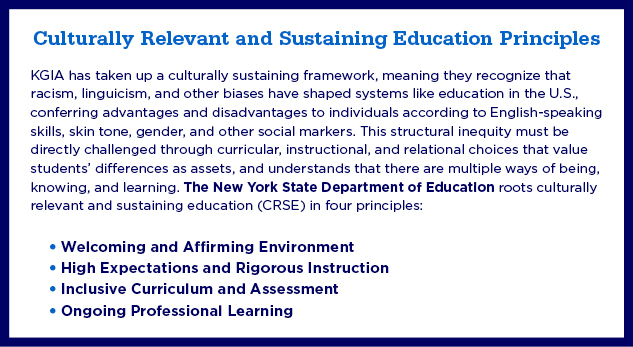

Freshmen advisory grew out of two supports that put more students on track toward graduation and raised attendance with each successive year: an attendance team inspired by restorative justice practices, and what they call Senior Success Teams to help 12th graders name and navigate their obstacles, and ultimately reach graduation.
When KGIA saw over 50% of its student body chronically absent in the 2018-19 school year, KGIA’s assistant principal, dean, some teachers, and school social workers developed an approach, inspired by restorative justice circles, to support rather than penalize students and families for missing classes. Restorative justice circles can take different forms, but all essentially draw together members of a community to address the root of a conflict or challenge rather than leverage disciplinary measures, and create a plan that centers healing and support. Each attendance team member worked with two to three chronically absent students, or “focal students”, with whom they already shared a relationship and their families to identify the cause of their absences.
By finding pockets of time outside instruction to chat with students and reach out to families, attendance team members found that to support their families, some students watched siblings, worked at family businesses, and attended to other family matters during school hours. And, according to teacher and former attendance team member Jennifer DeFelipo, many students also felt disconnected from the school, particularly as new students or students new to the country, and simply did not want to attend. The attendance team shared these findings in biweekly meetings, and collaboratively developed supports on a case by case basis to increase each students’ learning time. Additionally, the team along with other staff at KGIA created game nights, movie nights, and other community events to make students feel more welcome, more comfortable, more interested in coming to a school.
Then, in the following academic year of 2019-2020, Principal Manalo and a team of teachers formed Senior Success Teams in response to the low graduation rates. 12th grade teachers each met with a small group of 10 students every two weeks to review their goals, and support their progress. These small group meetings provided space for students to not only check in with an adult about their academics and attendance, but build community with their peers, and problem-solve any challenges they may be facing, including social-emotional.
As a result of their attendance work and Senior Success Teams, KGIA saw students make strides: Last year the school celebrated an 81% graduation rate, something it had never seen before. Fewer students have been considered ‘at risk’ for chronic absences, celebrating an 86% attendance rate for the 2021-2022 school year, and even averaging above 90% attendance in one week. As Principal Manalo shared, their attendance work, Senior Success Team, and all other subsequent supports come down to the way KGIA educators invest in relationships, and take time to listen to students.

Recognizing the impact of their previous work, in September 2020, KGIA developed an advisory modeled off of the Senior Success Teams and attendance work in order to better learn about and support the 20 students that comprised their incoming freshmen class. KGIA also intended for advisory to inform and be informed by the College Readiness Network for School Improvement (CR NSI) team. Starting in the 2020-2021 school year, New Visions along with a team of ninth grade teachers collaborated to analyze students’ academic progress and refine their instruction, with the goal of raising students’ GPAs to 80% or higher.
Cherlyse Alexander, a geometry and algebra teacher, and a CR NSI team member, volunteered to lead Advisory and meet with ninth graders five days a week. She framed advisory as a class to help students get comfortable not just moving from middle school to high school, but comfortable opening up to one another, and adults in the building.
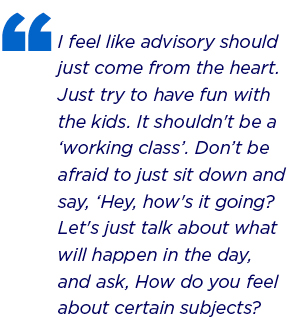
Through this open approach, she created themes for each day of the week that were informed by CR NSI input, social emotional surveys given to students at the start of each semester, and the interests students expressed to her directly. While Alexander’s lessons were open to this feedback, she noted that keeping weekly themes helped her not feel overwhelmed, and helped students feel comfortable knowing what to expect.
She devoted Tuesdays to “college and career readiness”, which included discussions around high school graduation requirements in the U.S., and study skills and strategies that work for them. They also researched colleges, learned how to write an email to teachers, peers, and others, and wrote “brag sheets”, or lists of their skills, assets, and accomplishments not only as students but as people, so they can, as Alexander noted, begin building the confidence to ask teachers for letters of recommendation to college.
Alexander also created “Check-in Wednesdays” for students to review their Google Classrooms, and catch up on assignments. Additionally, for 8 weeks, Alexander invited other adults to visit the class on Thursdays to share how they organize their calendars, take notes, and maintain healthy routines (i.e. a healthy amount of sleep, time to spend with family and friends, time to learn, time to exercise). Students then created an outline of their own routines, and discussed them as a class. Alexander shared that these outlines provided her and other teachers with a wider picture of their students’ lives, and how some responsibilities at home intersected with school.
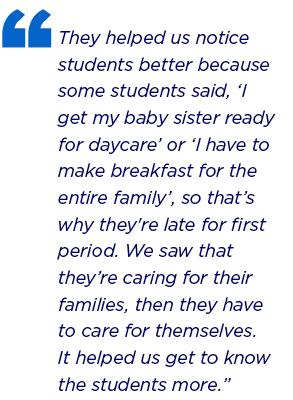 Alexander also dedicated the other class days to one social emotional area as outlined by CASEL: self awareness, self management, social awareness, building relationships, and thinking through and making decisions. Alexander rooted these lessons to students’ lives, cultures, and lived experiences with the aim of helping them feel comfortable and build connections. For example, over Spring Break, students created playlists, then shared their playlists when they returned.
Alexander also dedicated the other class days to one social emotional area as outlined by CASEL: self awareness, self management, social awareness, building relationships, and thinking through and making decisions. Alexander rooted these lessons to students’ lives, cultures, and lived experiences with the aim of helping them feel comfortable and build connections. For example, over Spring Break, students created playlists, then shared their playlists when they returned.
Alexander shared students’ advisory creations – like their routine outlines and playlists – with the CR NSI team, which helped them see and respond to individual students’ needs more fully, and provided possible explanations for their “noticings." During CR NSI meetings, Alexander shared that teachers discuss what they notice about students, analyze if there are shared noticings, discuss what they know about the students’ lives, then if necessary discuss how to best support if the noticings are, for example, a student showing signs of depression, or a student no longer engaging class.
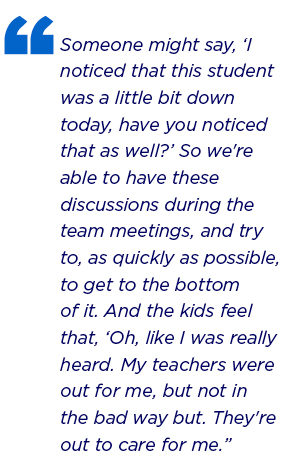 Additionally, each CR NSI team member acts as a mentor to individual freshmen, and checks in at least once per month with them for anywhere from 5 to 20 minutes to discuss how they’re feeling about school, learning, relationships, or any other topic (including Birthday celebrations!) students might want to talk about. To be clear, teachers are not assigned to check-in with one particular student. Rather, the team determines who should talk to a particular student for a particular situation, or teachers have casual conversations with students. In either case, they document that a conversation was had in a shared tracker so that the entire team can make sure they are keeping in contact with each student.
Additionally, each CR NSI team member acts as a mentor to individual freshmen, and checks in at least once per month with them for anywhere from 5 to 20 minutes to discuss how they’re feeling about school, learning, relationships, or any other topic (including Birthday celebrations!) students might want to talk about. To be clear, teachers are not assigned to check-in with one particular student. Rather, the team determines who should talk to a particular student for a particular situation, or teachers have casual conversations with students. In either case, they document that a conversation was had in a shared tracker so that the entire team can make sure they are keeping in contact with each student.
Through Alexander and the CR NSI team’s model, advisory courses have supported a culture of belonging, and helped teachers more intentionally engage with students.

Now back in person, KGIA has extended advisory into the 10th grade, and has taken other steps to make students feel more welcome, seen, and heard at school, in response to their most recent form of outreach – a social-emotional learning survey. For example, Manalo shared that after noticing Muslim students use random places in the school to pray, and after seeing this challenge described in the survey, KGIA transformed an office space into a multi-purpose room that students of any denomination can use for prayer, meditation, or study. KGIA has also created a photography class in order to help students work through traumas they have shared and described in the survey. The class emerged from CR NSI meetings around students’ SEL needs, and is led by CR NSI team member Carrie Lynch, who has experience with photography as a form of self expression.
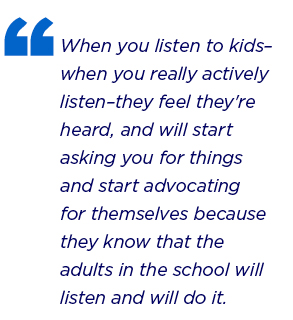
Additionally, Manalo has started a boy’s group, working with 13 students who self-identified as needing more support and space to share and collaboratively address the pressures they feel as young men. And eventually, as Manalo shared, he would like to include students in instructional walk-throughs because he wants to understand, from a young adult’s perspective, how he and other educators can facilitate learning through more intentional instruction. Manalo attributes all of the positive changes they have seen in students to the concerted effort teachers have placed on listening to students.
